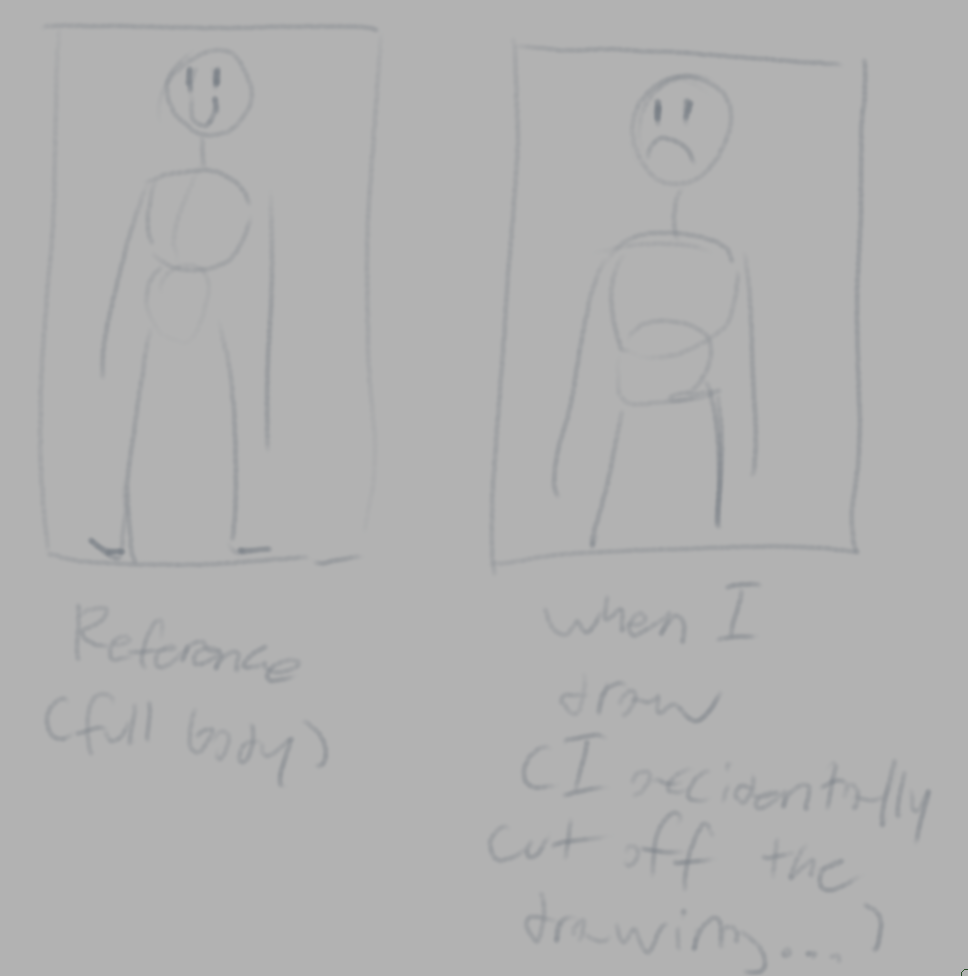This topic contains 6 replies, has 3 voices, and was last updated by
![]() Aunt Herbert
11個月前.
Aunt Herbert
11個月前.
- 訂閱 喜歡
-
April 13, 2024 4:16pm #31346Hello! I've found this website, and it's a great help. However, I've found one main problem when I draw: I seem to have trouble with the proportions. basically, something like the below happens:

I would usually resize the canvas or erase to make room, but I don't think it's a good habit, plus, when the figure drawings are timed, it does take a considerable amount of time away from what I could've been using to draw the poses. I've tried the enveloping method (where you draw something like the basic shape around the figure? unsure how to explain), and it does help me quite a bit, but if there's any other tips/methods I could use, it'd be gladly appreciated. Thanks! April 13, 2024 5:04pm #31347The very simple sounding, but very hard to pull off trick: Learn to establish the biggest shapes first, so you can measure the details from them.
April 13, 2024 5:04pm #31347The very simple sounding, but very hard to pull off trick: Learn to establish the biggest shapes first, so you can measure the details from them.
This is going to be important for a hundred different reasons, and unless you are completely different from most other people, it will take you quite some time from understanding the general idea, to experimenting how to put it into practise, to becoming so accustomed to working that way, that you no longer have to constantly focus on it and can start paying attention to other problems more.
But it will fix 90% of all your problems with proportions, be they about composition or about anatomy.
Edit: Maybe a more practical tip for the stage that you are at right now: Not every figure drawing has to capture the entire figure. If you realize, that you started the figure too big to fit on the paper, don't waste time fiddling around with the frame size. Just focus on drawing the parts that do fit as good as possible. So you end up with only a half-pose? So what. You start your next drawing immediately afterwards, and can avoid that specific mistake now. Learning is about making mistakes, realizing it was a mistake, and then not worrying, but just carrying on and trying to avoid repeating that mistake.-
 Aunt Herbert
edited this post on April 13, 2024 4:28pm.
Aunt Herbert
edited this post on April 13, 2024 4:28pm.
April 15, 2024 4:34pm #31356I think this video has a bunch of practical tips to try while you still feel insecure about proportions:
April 15, 2024 8:46pm #31357Hey, thanks a lot for the advice so far! I'll check out that video.
about establishing the biggest shapes first, is this the "blocking" method? or is it something else entirely? I'm not sure if I entirely follow, ahahaApril 16, 2024 3:14am #31359Hey there, Moriya. How are you doing tonight? You know, greater jobs on addressing your own problem that you really want and need to solve for yourself, but with a little help from me and all of us. We all understand that when attempting to draw the fuller figure, you're more easily tempted to draw the stuff out detail by detail, which is what we art, cartooning, and animation students need to keep it constantly in check. So, may I please just suggest and recommend you just go for the broader lines, shapes, and spaces (silhouettes and negatives), prior to your measuring out your relationships (or proportions and angles)?
Yet, the idea of this littler suggestion is because, by roughly mapping out the gesture drawing of the figure, it can and will be quite a more completely useful blueprint for your pose's proportions and angles as you can and will give your gestures even more structure and stability.
Therefore, if you're still completely and totally noncommital, please check out that video above, and another of of these below:
https://youtu.be/CJqCEA9boas
Let's hope they've been completely and absotively-posilutely helpful.April 16, 2024 11:45am #31360Moriya, it's just a common and natural beginner's mistake to start every drawing by focusing on one detail first, then the next adjacent detail, and so forth. Which inevitably leads to the problem of minor variance in scale between each of the details multiplying with each other, until the last detail is much bigger in scale than the first one, and off by inches in either the vertical or horizontal axis.
What you describe about your figure no longer fitting into your frame is just a variation of that problem.
And the fix to it is to learn to establish the big overall shapes as soon as possible, so you can measure all details relative to those big shapes, and not from detail to detail.
Besides measuring proportions better it also allows getting a grip on composition.
You will find this principle in several different drawing techniques, named differently depending on subject and the method to establish the big shapes.
You will even find similar effects when you start to investigate how shading works and learn how to establish the big values first.
I have been drawing daily for several years now, and when I am particularly annoyed about proportions or compositions in the result in one of my drawings, and I ask myself: "Did you maybe jump into fiddling with details before you established the big shapes?" the answer is in 90% of cases: "Yepp, guilty as charged"-
 Aunt Herbert
edited this post on April 16, 2024 9:50am.
Aunt Herbert
edited this post on April 16, 2024 9:50am.
-
 Aunt Herbert
edited this post on April 16, 2024 10:31am.
Aunt Herbert
edited this post on April 16, 2024 10:31am.
-
Login or create an account to participate on the forums.







